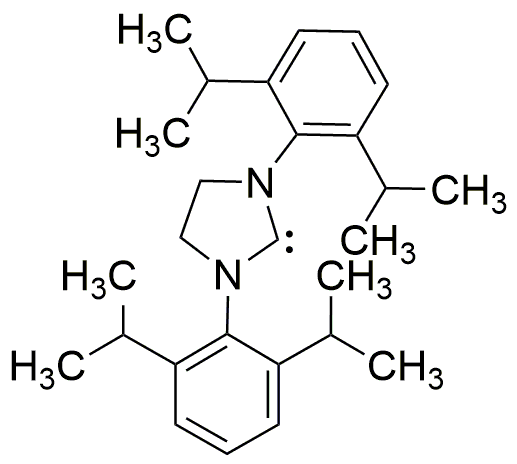1,3-Bis(2,6-diisopropylphenyl)imidazolidin-2-ylidene is widely utilized in research focused on:
- Catalysis: This compound serves as a highly effective ligand in various catalytic processes, particularly in cross-coupling reactions, enhancing reaction rates and selectivity.
- Organic Synthesis: It plays a crucial role in the synthesis of complex organic molecules, enabling chemists to create compounds with precision and efficiency.
- Material Science: The compound is used in the development of advanced materials, including polymers and nanomaterials, due to its unique structural properties.
- Pharmaceutical Development: It is applied in drug discovery and development, particularly in the design of new therapeutic agents, thanks to its ability to stabilize reactive intermediates.
- Research in Coordination Chemistry: This chemical is valuable in studying coordination complexes, helping researchers understand metal-ligand interactions and their applications in various fields.
General Information
Properties
Safety and Regulations
Applications
1,3-Bis(2,6-diisopropylphenyl)imidazolidin-2-ylidene is widely utilized in research focused on:
- Catalysis: This compound serves as a highly effective ligand in various catalytic processes, particularly in cross-coupling reactions, enhancing reaction rates and selectivity.
- Organic Synthesis: It plays a crucial role in the synthesis of complex organic molecules, enabling chemists to create compounds with precision and efficiency.
- Material Science: The compound is used in the development of advanced materials, including polymers and nanomaterials, due to its unique structural properties.
- Pharmaceutical Development: It is applied in drug discovery and development, particularly in the design of new therapeutic agents, thanks to its ability to stabilize reactive intermediates.
- Research in Coordination Chemistry: This chemical is valuable in studying coordination complexes, helping researchers understand metal-ligand interactions and their applications in various fields.
Documents
Safety Data Sheets (SDS)
The SDS provides comprehensive safety information on handling, storage, and disposal of the product.
Product Specification (PS)
The PS provides a comprehensive breakdown of the product’s properties, including chemical composition, physical state, purity, and storage requirements. It also details acceptable quality ranges and the product's intended applications.
Certificates of Analysis (COA)
Search for Certificates of Analysis (COA) by entering the products Lot Number. Lot and Batch Numbers can be found on a product’s label following the words ‘Lot’ or ‘Batch’.
*Catalog Number
*Lot Number
Certificates Of Origin (COO)
This COO confirms the country where the product was manufactured, and also details the materials and components used in it and whether it is derived from natural, synthetic, or other specific sources. This certificate may be required for customs, trade, and regulatory compliance.
*Catalog Number
*Lot Number
Safety Data Sheets (SDS)
The SDS provides comprehensive safety information on handling, storage, and disposal of the product.
DownloadProduct Specification (PS)
The PS provides a comprehensive breakdown of the product’s properties, including chemical composition, physical state, purity, and storage requirements. It also details acceptable quality ranges and the product's intended applications.
DownloadCertificates of Analysis (COA)
Search for Certificates of Analysis (COA) by entering the products Lot Number. Lot and Batch Numbers can be found on a product’s label following the words ‘Lot’ or ‘Batch’.
*Catalog Number
*Lot Number
Certificates Of Origin (COO)
This COO confirms the country where the product was manufactured, and also details the materials and components used in it and whether it is derived from natural, synthetic, or other specific sources. This certificate may be required for customs, trade, and regulatory compliance.


